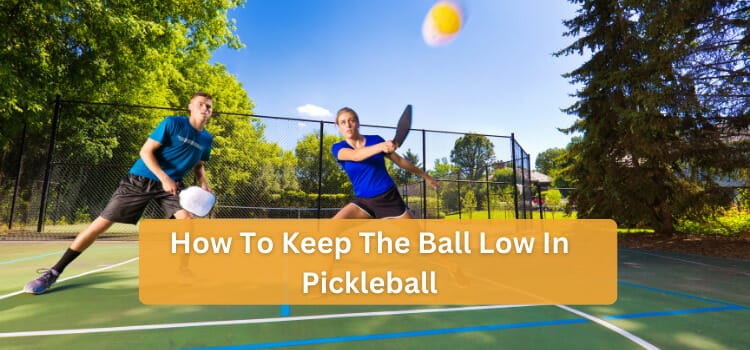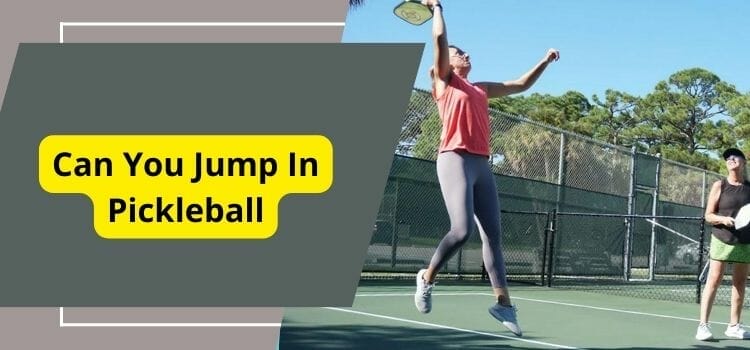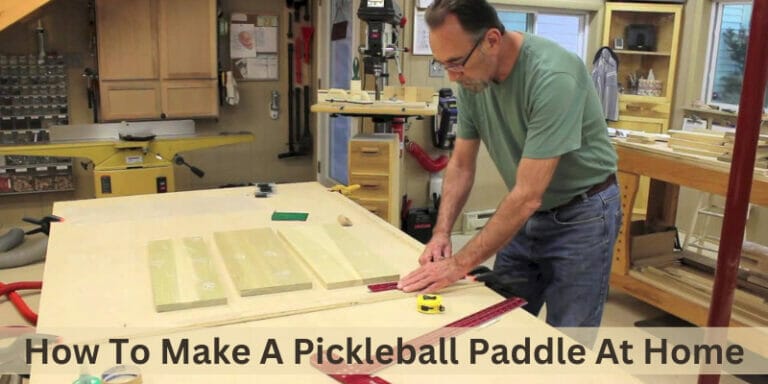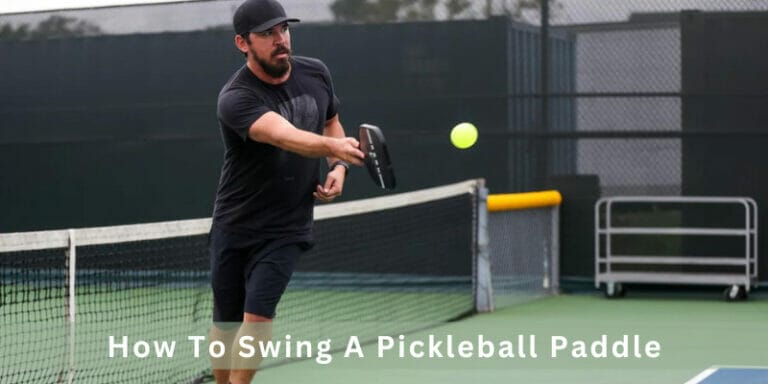How To Keep The Ball Low In Pickleball

Key Takeaway:
- Reducing the swing is crucial for keeping the ball low in pickleball. A short, controlled swing allows for more accuracy and consistency.
- Having soft hands is also important. Too much tension in the grip can cause the ball to bounce higher. A relaxed grip allows for a softer touch on the ball.
- Dinking cross-court can keep the ball low and force your opponent to move laterally. By hitting a cross-court dink, you can keep the ball away from the taller and stronger parts of the net.
Tips To Keep The Ball Low In Pickleball
As a pickleball player, I constantly strive to improve my game. One aspect of the game that I personally find challenging is keeping the ball low.
Keeping the ball low can be difficult, but it is essential for ensuring that your shots stay in play and don’t give your opponents the advantage.
In this section, I’ll share some tips that have helped me keep the ball low in pickleball. These include reducing your swing, maintaining soft hands, playing your shots early, and keeping your paddle low – all of which can make a significant difference in your game.
Additionally, I’ll discuss some other strategies, including drinking cross-court and hitting the net when appropriate, as well as practical advice such as maintaining a distance between your body and the ball.
Finally, I’ll share why it is important to practice consistently and aim to keep your mind relaxed while playing.
1: Reduce The Swing
Reducing the swing is crucial in pickleball as it helps to keep the ball low and close to the net, making it more difficult for opponents. Here’s a step-by-step guide on how to reduce the swing effectively:
- Hold the paddle firm but relaxed: A loose grip ensures that your wrists are free to move while hitting shots.
- Shorten the backswing: A shorter backswing reduces your overall swing and helps control the power you put into your shot.
- Control the follow-through: A controlled follow-through gives you additional touch and control over where the ball goes.
- Use fingers instead of arms: By using your fingers instead of your arms, you can generate enough power without exerting force, thus reducing unnecessary movement.
To reduce swing, players must also keep their bodies relaxed and composed while hitting shots. It’s essential to maintain a proper stance by standing slightly sideways and using wrist motion rather than hand or arm movements while executing strokes.
Pro tip: Repeated practice with a focus on technique is key to efficiently reducing your swing in pickleball – remember perfect practice makes perfect performance!
If your hands are harder than your heart, you’re doing it wrong. Soft hands are key to success in pickleball.
2: Have Soft Hands
Soft hands in pickleball refer to having a gentle touch with the paddle. By keeping your grip soft and relaxed, you can control the ball’s power and direction. Soft hands are also crucial for making small adjustments while hitting the ball.
To have soft hands, ensure that you do not grip the paddle too tight as this will lead to tension in your hands and arms. Instead, loosen your grip slightly and allow your fingers to wrap around the handle comfortably. By doing so, you can easily adjust the angle of the paddle to hit different shots.
It is important to note that soft hands are not just essential for maintaining control during rallies; they also reduce strain on your arms, preventing injury over time.
Keeping your hands relaxed will make it easier for you to play both forehand and backhand shots with equal ease. When approaching a shot, focus on keeping your arms loose and allowing your wrists to work naturally rather than forcing them into position.
Remember, in pickleball, dinking cross-court is like the quiet kid in class who always gets an A.
3: Dink Cross-Court
The Art of Hitting Soft Shots Diagonally Across the Court
Hitting a dink cross-court is one of the crucial skills in pickleball. In this technique, players hit a slow-moving shot diagonally across the court to their opponent’s backhand. This shot puts them out of position to return it effectively, increasing your chances of winning the game.
To execute a dink cross-court, players must keep their wrist loose and hit the ball with an upward angle rather than hitting it flat. This shot should be aimed at the sidelines near the net, making it difficult for your opponent to reach.
Moreover, players can use this shot during rallies when trying to move their opponents around. It can also be used as part of a strategy to force opponents off balance or create opportunities for stronger shots.
However, never overuse this technique as it decreases its effectiveness and predictability could lead to loss of points.
Invented by Barney McCallum, Joel Pritchard, and Bill Bell in 1965; Pickleball has evolved from its humble beginnings into an internationally recognized sport played by millions worldwide. As pickleball grows in popularity around the globe every day, mastering techniques such as dink cross-court could take you one step closer to being unbeatable on any court.
Get ahead of the game by playing your shot early, because tardiness in pickleball is a pickle you don’t want to be in.
4: Play Your Shot Early
Anticipating the ball’s trajectory and playing your shot before it reaches you is crucial in Pickleball. By initiating your hit early, you have a better chance of keeping the ball low while ensuring that your volley lands where you intended. Playing your shot early also ensures that you do not rely on reflexes alone, reducing the likelihood of missing an easy return.
Mastering the art of ‘early’ play doesn’t come naturally to players; rather, it requires practice and fine-tuning. Therefore, ensure that you’ve perfected your footwork and racket placement because it will help fuel confidence levels when taking shots at the net.
Playing Your Shot Early can significantly improve a player’s technicalities resulting in their overall gameplay being successful. Additionally, it helps them keep up with quick volleys and maintain control over their shots.
Pro Tip: One unique aspect of Pickleball compared to other racket sports is mastering how to play accurate drop shots while still keeping the ball low. Therefore, practicing drop shots should be incorporated when mastering Playing Your Shot Early to keep opponents guessing where the next shot might come from.
Keep your paddle low, unless you really enjoy playing limbo with the ball.
5: Keep Your Paddle Low
Maintaining a low paddle height is essential to master the Pickleball technique. Read on to learn more about how to keep your paddle low in an informative and formal tone.
- Positioning
Make sure your grip is relaxed, and the angle of your wrist is positioned downwards comfortably. Bend your knees slightly to lower the center of gravity, which will make it easier for you to move quickly. - Absorb Shock
As you hit the ball, try not to tense up your muscles – they need to remain loose to avoid repelling excess energy up through the handle toward your wrist. Your arm should be pliant enough so that it can absorb the shock received while maintaining control over the ball’s velocity. - Follow-through movement
Practice following through with your swing after hitting the ball so that you don’t cut off movement by stopping at contact – this will help you optimize momentum toward lowering your paddle height successfully.
It’s vital to master keeping your paddle low because doing this makes it more challenging for opponents returning shots since they have less court space available when hitting upwards. Furthermore, mastering this technique helps you improve hand-eye coordination, agility, and reaction speed during a game.
While playing Pickleball tournaments last summer, I encountered a player who mastered keeping his paddle low. This skill allowed him to return my shots faster and with greater accuracy than other players I faced. Adapting his style helped me assess my own skills better and improve upon them.
Overreaching on volleys is like reaching for a bad Tinder match – you’ll just end up disappointed.
6: Avoid Overreaching on Volleys
When playing pickleball, it is essential to avoid overreaching on volleys. Overreaching can lead to loss of control and hitting the ball out of bounds. To prevent overreaching, players should focus on maintaining a comfortable distance between themselves and the ball. By keeping their body in alignment, and paddles close to the body, players avoid reaching out too far.
Furthermore, players can also adjust their position by moving forward or backward instead of overreaching on volleys. It is essential to keep good form and technique throughout the game, which helps reduce overreaching.
A unique detail to consider when avoiding overreaching is to place more emphasis on footwork during play. Players can move their feet into a better position before striking cords instead of simply stretching forward from where they stand. Proper footwork allows players to be in a better position for volleys while decreasing the need for aggressive reaching movements.
Pro Tip: Regardless of how excited you are at offering that final winning hit shot, do not reach too far as it will likely lose control of your swing and have you miss your target.
Take the risk and aim for the net – it’s not like you’re trying to impress a volleyball crowd.
7: Don’t Be Afraid To Hit The Net
In Pickleball, hitting the net while returning a shot is a common fear among players. However, it is essential to overcome this fear and take the risk of hitting the net, as it can help keep the ball low and decrease the opponent’s reaction time. Don’t be afraid to hit the net, as it can work in your favor.
When you hit the net while returning a shot, there are chances that the ball will bounce just over it and land on your opponent’s court, making it difficult for them to return. Additionally, though there is also a possibility that hitting the net may cause an error in your shot or make it easier for your opponent to return at times, taking risks like these can help you evolve as a player.
It is important to remember that Pickleball is all about strategy and taking calculated risks. Constantly practicing hitting the net shots can improve your skill set and decision-making abilities during gameplay.
During one of my first games playing Pickleball, I was hesitant to hit the net while returning a shot. However, after watching my opponent’s successful returns by hitting the net shots continuously, I started practicing them myself. Once I overcame my fear of hitting the net, I began increasing my success rate by keeping more balls low during gameplay – ultimately resulting in better performances for me on-court.
Watch out for incoming balls, they’re not gonna give you a heads-up.
8: Don’t Get Caught Off Guard With Direct Shots
When playing pickleball, one must develop quick reflexes and stay alert to avoid being caught off guard with direct shots. To anticipate and block incoming shots, players must keep their paddles up and be ready to move quickly.
If players are not watching carefully, they could miss a shot. This is particularly true for direct hits aimed at vulnerable spots on the court. Players can prevent being caught off guard by keeping their eyes on the ball as much as possible and anticipating where it is going next.
To increase the chances of getting to those direct shots, players should work on improving their footwork so they can move around the court effortlessly. Additionally, practicing hitting balls that come directly at you can help improve your reaction time.
Finally, it’s important not to panic when a fastball is coming directly at you. Instead, take a deep breath and focus on positioning your paddle correctly to block or return the shot effectively. With practice and patience, even direct shots will become easy to handle in no time!
Keep your distance like a pro wrestler keeping their opponent at arm’s length, and your pickleball game will have the same agility and grace.
9: Maintain A Distance Between Your Body And The Ball
To keep the ball low in pickleball, it is crucial to maintain a proper distance between your body and the ball. This helps you to hit the ball cleanly, avoid long shots, and increase ball control.
Here’s a six-step guide on how to maintain a distance between your body and the ball in pickleball:
- Position yourself correctly.
- Use your non-paddle hand as a guide to determine where the ball will land if it comes towards you.
- Move towards the projected landing spot of the ball.
- Bend slightly at the waist with knees flexed.
- Extend your paddle arm away from your body while keeping a light grip on it.
- Eyes focused on hitting zone till contact is made with the ball.
It is essential to remember that maintaining this distance does not mean standing too far away from the ball. It means positioning yourself correctly so that you can manipulate the angle of your shot effectively.
In pickleball, maintaining distance is very important because it allows players to react quickly, move swiftly, minimize errors, and play precisely. Therefore, whether you are at home or on a dedicated court, practicing these techniques regularly will improve your game.
When playing recreational pickleball with friends last summer, I met an experienced player who told me about his struggle with keeping his game tight – especially maintaining an optimal distance between his body and the ball. He took time away from competition until he obtained all-around basic skills for both singles and doubles matches; after perfecting them all over again, he resumed play more confidently than ever before.
Practice doesn’t make perfect in pickleball, but it sure does make the ball stay low.
10: Practice More & More
Practicing More for Greater Mastery
To improve your pickleball game, practice more and more. Constant practice is the key to developing the necessary skills required to keep the ball low. Here is a three-step guide to assist you in achieving this goal.
- Devote Time Every Day To Practice Pickleball
Regular training sessions devoted to practicing keeping the ball low will help you attain mastery. - Focus On Drills That Emphasize Keeping The Ball Low
Working exclusively on reducing your swing, dink cross-court, hitting early shots, and keeping your paddle low are all good drills that can be used for this purpose. - Break Down Your Game For Improvement
Breaking down your game into manageable parts also helps in improving specific aspects of it with greater precision.
To expand further, maintaining focus and remaining relaxed can aid in staying sharp during extended periods of training sessions. Sipping fluids regularly during games while taking deep breaths between points helps maintain good stamina and mental focus throughout the game.
Keep these tips in mind to become a master of keeping the ball low in pickleball. Remember, it’s just pickleball, not a battle for world domination – so keep your mind relaxed and your paddle low.
11: Keep Your Mind Relaxed
One of the key aspects of successful pickleball play is to maintain a calm and relaxed mindset. When playing a fast-paced game, it’s easy to get caught up in the moment and become tense, which can ultimately impact your overall performance. By keeping your mind relaxed, you’ll be able to focus more on making accurate shots and reacting quickly to the ball.
To achieve this relaxed mindset, there are a few techniques you can try:
- Take deep breaths between rallies to help slow down your heart rate and clear your mind.
- Additionally, don’t put too much pressure on yourself to win every point – remember that mistakes are a natural part of the game and everyone makes them.
- Finally, try to stay positive and maintain a supportive attitude towards yourself and your partner.
Maintaining a relaxed mindset not only helps you perform better on the court but also promotes mental clarity and reduces overall stress levels. By prioritizing relaxation techniques off-court as well, such as yoga or meditation, players may find that they’re able to apply these skills during their matches as well.
In fact, many professional athletes across various sports have spoken about the benefits of maintaining a relaxed mindset during competition. For instance, Serena Williams has shared that she regularly practices deep breathing exercises during breaks in her matches to help keep herself focused and calm under pressure. By incorporating relaxation techniques into their routine both on and off-court, players may be able to improve their overall pickleball game.
Why Is Keeping The Ball Low Important In Pickleball?
Keeping the ball low in pickleball is crucial to winning the game as it prevents the opponents from attacking and gives a player control over the rally. A low ball forces the opponents to hit upwards, making it easier to return the ball effectively and increasing the chances of securing a point. Not only does it limit the opponents’ options, but it also reduces the risk of committing an unforced error.
In pickleball, a player can keep the ball low by employing a variety of techniques such as using the underspin, drop shots, and dinks.
The underspin creates a lower trajectory for the ball, while a drop shot is a strategy that involves hitting the ball low and landing it near the opponent’s net.
Dinks are another effective way of keeping the ball low by hitting it gently over the net at a low trajectory, forcing the opponents to hit upwards.
It is worth noting that the importance of keeping the ball low is often overlooked by beginner players. They tend to hit the ball too high, resulting in an easy return for the opponents.
However, experienced players understand the value of maintaining a low ball, making it challenging for the opponents to return. To improve their game, players must practice and master various techniques to keep the ball low effectively.
I remember a time when I was up against an opponent who always hit the ball high, giving me the chance to attack easily and secure points. However, during one match, my opponent employed a variety of tricks to keep the ball low, making it incredibly challenging for me to return effectively. That experience highlighted the importance of keeping the ball low in pickleball and motivated me to master various techniques to improve my game and stay ahead of the competition.
Five Facts About Keeping The Ball Low In Pickleball:
- ✅ To keep the ball low in pickleball, it’s important to reduce the swing and make the movement of your paddle shorter. (Source: Team Research)
- ✅ Having soft hands and using lighter pressure on the paddle can also help keep the ball low and avoid pop-ups. (Source: Team Research)
- ✅ Dinking cross-court rather than straight across can give you more space and fewer chances of pop-ups. (Source: Team Research)
- ✅ Hitting the ball early and keeping your paddle low can also prevent higher shots and pop-ups. (Source: Team Research)
- ✅ Practicing as much as possible, watching professional games, and keeping your mind relaxed are all beneficial in keeping the ball low in pickleball. (Source: Team Research)
FAQs about How To Keep The Ball Low In Pickleball
How can I play early in pickleball to keep the ball low?
To avoid pop-ups in pickleball, it is important to hit the ball as early as possible. Waiting too long can cause the ball to go higher than intended, so try to play your shot early and don’t waste any time.
What is the right position to keep my paddle in to keep the ball low in pickleball?
Keeping your paddle low can help you make the correct move and prevent higher shots. Put your paddle at a lower angle and avoid adding additional angles while dinking to complete the movement without any faults.
Is hitting the net allowed in pickleball to keep the ball low?
While hitting the net is generally a fault in pickleball, hitting toward the net can sometimes help you avoid higher shots and keep the ball low. However, this technique requires practice and should be used sparingly.
How can I maintain distance from the ball to avoid higher shots in pickleball?
To prevent making mistakes in the heat of the moment, it is important to maintain a distance between your body and the ball. This can help you make better decisions and maintain your position in the court.
How can keeping my mind relaxed help me keep the ball low in pickleball?
Maintaining a relaxed state of mind can help you perform better in pickleball. When you’re stressed or anxious, you may be more likely to make mistakes, including hitting higher shots. So, keep your mind relaxed and enjoy the game!
Why is it important to keep the ball low in pickleball?
Keeping the ball low in pickleball can prevent your opponent from making aggressive shots, as lower shots are harder to hit back. It can also help you maintain your pace and avoid stress on the court.






